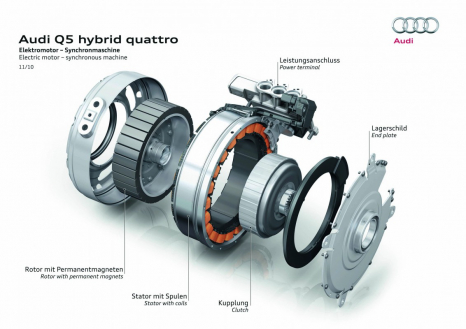Electric motors
Electric motors are outstanding in their high reliability, low weight and high efficiency – in the range of 93 to 97 percent through a relatively broad rpm range. Unlike internal combustion engines, electric motors yield their maximum torque at extremely low rpms, practically from the starting position. For this reason, single-stage transmissions are usually all that’s needed in purely electrical vehicles.
The electric motors employed by Audi as drive systems can be divided into two groups. One group comprises the so-called asynchronous motors (ASM). Asynchronous motors do not require permanent magnets with exotic, rare-earth materials. They are simple in design, sturdy, low-maintenance and long-lived. However, they are only suitable for transmission-integrated applications to a certain extent. The second type comprises permanently excited synchronous motors (PSM). Their higher power density generally allows a more compact, lighter design. In addition, high torque and high efficiency can be attained in the lower rev range.
The performance of an electric motor depends on its design; power and torque can be adapted by varying the length and diameter. In hybrid vehicles, Audi employs PSMs designed specifically for high torques. They have a large diameter, but are only a few centimeters long and can therefore be easily integrated between the combustion engine and the transmission. Their optimal rev range between 500 and 5,000 rpm harmonizes superbly with the torque characteristics of a combustion engine.
For vehicles driven electrically either frequently or permanently, power-optimized PSMs and ASMs are suitable in their high-rev versions. The diameters of these motors are smaller than in the torque-optimized electric motors. On the other hand, they are considerably longer and feature a significantly broader usable rev range.
All electric motors used by Audi are cooled by liquid so as to maintain their reliable operating temperature of at most 180 degrees Celsius (356 degrees Fahrenheit). While the thermal factor limits the power potential, short-term violations of the limit are permitted. The electric motor in the A1 e-tron, for example, achieves a continuous power of 45 kW (61 hp) and a peak power of 75 kW (102 hp).
Since electrically powered cars are essentially silent up to speeds of approximately 25 km/h (15.53 mph), they pose a potential risk for pedestrians and bicyclists. Audi is therefore developing an artificial sound for its hybrid and electric vehicles.
Status: 2011
